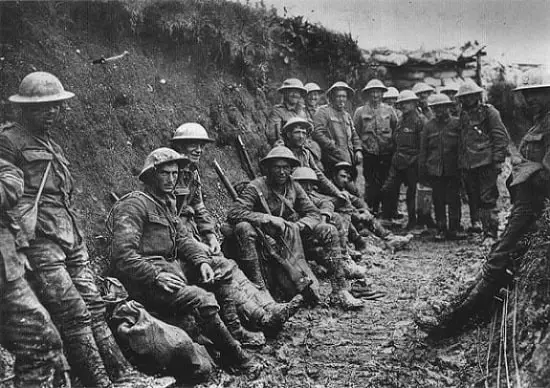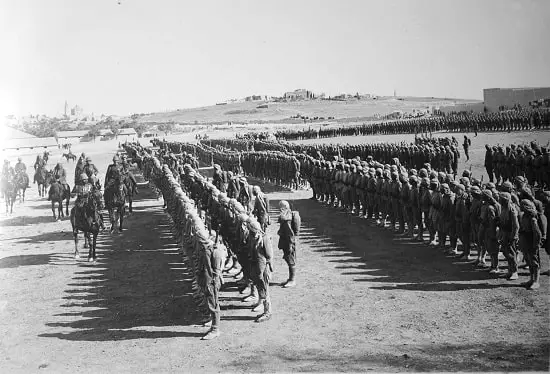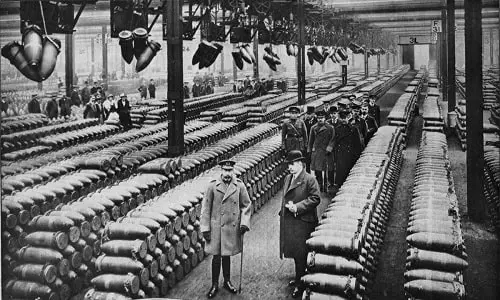World War 1, 1914 AD to 1918 AD, was a worldwide conflict that engaged many principal nations from around the globe.
This war that went on for over four years is considered one of the deadliest conflicts in history based on death tolls.
The overall number of military and civilian casualties was approximately 40 million. Civilian casualties alone measured about 6 to 13 million.
An estimated 9 to 15 million military personnel died, and 21 million were injured.
The assassination of the presumptive heir, Archduke Franz Ferdinand, by Gavrilo Princip triggered this history-making conflict in June 1914.
The carnage was incomprehensible to everyone, and neither the leaders nor the civilians were prepared for the length and brutality of the war.
The loss of life happened faster than in any other former war. Some factors that influenced the high mortality and casualty rate are discussed hereunder:
Why were there a lot of casualties in the trenches?
Content
Many soldiers died due to attacks and explosions in the trenches.
Artillery and mortar shells caused heavy casualties. In addition to combat deaths, many died in trenches due to famine and diseases.
What caused the high deaths on the Western Front?
The deadlock on the Western Front caused both sides to try to break through the enemy’s defensive positions.
Due to the war being highly defensive at the front, troops were forced to break in and caught in frontal assaults. This approach resulted in a high death rate in that zone.
Which country faced the most casualties during World War 1?
Russia had the most casualties during world war 1.
The Allied nation suffered 9,150,000 casualties comprising 1,700,000 deaths, 4,950,000 wounded and 2,500,000 missing and prisoned.
5. Infectious diseases

In 1914, as world war 1 began, bacteriology had matured as a science, but there were no antibiotics.
The lack of pharmaceutical knowledge meant no legitimate cure to a disease, and transmissible illness would spread rapidly.
Although the majority of deaths were caused due to battle injuries, infectious diseases were also responsible for the loss of life of both military personnel and civilians.
The prevailing conditions were trench foot, fever, typhus, and influenza.
Poor hygiene and lifestyle in the trenches made it a breeding place for diseases. Trench foot was a significant problem during the initial stages of the war.
It was an infection that made soldiers’ feet turn red or blue due to standing in the waterlogged trenches for a long time. This condition, if worsened, often leads to gangrene or even amputation.
Subsequently, improvement in the quality of military boots helped minimize this condition.
Another significant disease prevailing in the trenches was trench fever. This disease was bred and transferred by body lice.
Due to the unhygienic and compact setup in the trenches, body lice would quickly grow and transmit the disease among soldiers.
Muscle aches, headaches, sores on the skin, and continuous attacks of fever were primary symptoms. The infection rose to about one million at its peak, causing quite some deaths.
Typhus or ship fever was also transmitted among the soldiers through body lice, which was seen mainly during world war 1.
The disease caused massive deaths due to the absence of antibiotics. The mortality rate varied from 10 to over 80 percent.
The Great Influenza epidemic, also known as the Spanish flu, began in February 1918, when World War 1 was its final month.
This deadly global pandemic claimed numerous lives during the ongoing war until 1920. The highest mortality rate was in October 1918, before the war ended.
4. Starvation

One of the primary reasons for deaths during World War 1 was starvation and famine-related diseases.
As the war went on, the utilization of significant resources for military purposes started taking a toll on the general needs of the population.
Farms had either been transformed into battlefields or had been left to wither. Workers in the agricultural field were forced into warfare, and transportation disruptions made the distribution of imported food extremely challenging.
A state of civil disorder began in all the warring nations as physical privations mounted both in the trenches and on the home front.
More frequent food shortages and strikes became a regular sight. In 1916, famine grew in Germany and across Europe majorly.
For apparent reasons, the belligerents prioritized rations for soldiers on the frontlines, leaving civilians to make ends meet in a scarce situation.
Rapidly dropping harvest and difficulty in import caused nations to cut out the food portions of the military personnel.
Civilians were affected significantly as the growing scarcity of food left them vulnerable to starvation and diseases with no proper healthcare.
Germany alone faced an estimated 750,000 deaths due to famine during this period that came to be known as the Turnip Winter.
The spread of starvation among the soldiers and all classes of civilians gave rise to a high mortality rate and even political dissent.
3. High rate of war crimes

War crimes in the situation of a global conflict are inevitable. World war 1 saw gruesome massacres, hostage killings, and the murder of soldiers and civilians.
One of the most brutal killings was the Armenian genocide from 1915 to 1917 AD. It was the systematic destruction of the Armenians and their identity in the Ottoman Empire.
This genocide destroyed the Armenian population in eastern Anatolia for over two thousand years. An estimated 600,000 to 1 million Armenians were murdered in death marches and shootings.
Another major massacre was the Assyrian genocide, infamously known as the Sayfo. This massacre was Syriac Christians’ mass slaughter and eviction in southeastern Anatolia and Iranian Azerbaijan from January to May 1915 AD.
The massacre was conducted majorly by Ottoman soldiers and other irregulars, including Kurdish tribes.
Mass killings began during the invasion of Iran in World War 1, which wiped out almost half of the population of these Assyrians. The estimated number of deaths was about 250,000.
The Greek genocide was another deadly massacre carried on throughout World War 1.
It included the killing of Christian Ottoman Greeks of Anatolia by order of the government of the Ottoman Empire and the Ankara Government.
The genocide included massacres, death marches, and summary execution to eradicate the Christian Ottoman Greeks from Ottoman Empire and Turkey.
The total number of deaths during the genocide period varies from 300,000 to 700,000. An estimated 84000 to 100,000 were killed during World War 1.
Genocides, combined with individual killings and homicides, caused many deaths during world war 1. The estimates vary widely, and accurate numbers may never be derived.
2. Technological advancement in weaponry

Technological aspects heavily influenced the vast destruction World War 1 caused. The trend of industrialization caused a ripple in the production and improvisation of war weapons.
Old weapons were improved to generate more effective destruction of the enemy, and new weaponry was introduced with the same objective.
These new techniques initially resulted in mass destruction and ineffective warfare as well. The introduction of poison gas and machine guns as war weapons was a prime reason for high military deaths on the battlefield.
The Germans dominantly produced poison gases in the initial phase of the war due to the advanced chemical industry. Later on, other belligerent nations followed up with their chemical weapons.
Chlorine, phosgene, and mustard gas were the primary chemical weaponry used during the Great War.
The use of poison gas resulted in more than a million casualties. About 900,000 deaths were caused due to the introduction of this chemical weapon of war.
Another improved and destructive weapon used during World War 1 was the machine gun.
In a stationary battle, the forward barbed wire-protected machine guns were effective war weapons and caused massive losses to the approaching enemy.
World War 1, sometimes called the machine-gun war, saw unparalleled carnage in previous history. This direct-fire weapon is a potent symbol of the Western Front of world war 1.
On July 1, 1916, around 21,000 British soldiers were killed due to the German machine guns.
The estimation of how many casualties machine guns were responsible for is still unknown.
A considerable percentage of the deaths and injuries on the battlefield due to infantry weapons was caused due to this deadly weapon.
Besides innovations, improved rifles and infantry weapons were another cause of massive loss of lives.
With accuracy and firing range made better, rifles caused way more deaths than they had caused in any prior conflict.
1. Highly-lethal artillery

Artillery was the prime cause of casualties in World War 1. The weapon was significantly developed as it was improved to fire highly explosive shells further away at a great fire rate.
Almost 60% of battlefield deaths were due to the explosion of deadly artillery shells.
The invention of the long barrel recoil majorly developed artillery functionality, and the weapon no longer had to be reset after firing a shot.
This improvement saved the operators a lot of time, and they could fire more shots in a short period causing colossal destruction.
Trench warfare was primarily adopted and enhanced to build more sophisticated and protected trenches due to the heavy use of artillery.
The straightforward trenches could no longer protect troops from artillery bombing and explosions.
Despite the introduction of numerous war weapons, artillery was the deadliest killer in the Great War and caused the most deaths.
The weapon was also behind the most significant source of war wounded.
Behind over 5 million casualties during World War 1 was artillery. It was the prime threat to ground troops, and artillery bombardment was most feared in the trenches.
Artillery destruction in the war was incomparable to those caused by other infantry weapons.
Conclusion
World War 1 saw mass casualties resulting from the growing technological times and numerous inventions in every field and aspect.
Developing and testing advanced war weapons were in full swing among all the combatants at the start and throughout the war.
The focus shift of every belligerent nation towards producing war resources resulted in the deprivation and shortage of necessities for military personnel and civilians.
Mass production was trending, and each nation competed to produce more resources.
All these factors combined brought about the vast number of casualties caused during the war. This made World War 1 an infamous and deadly global conflict.
